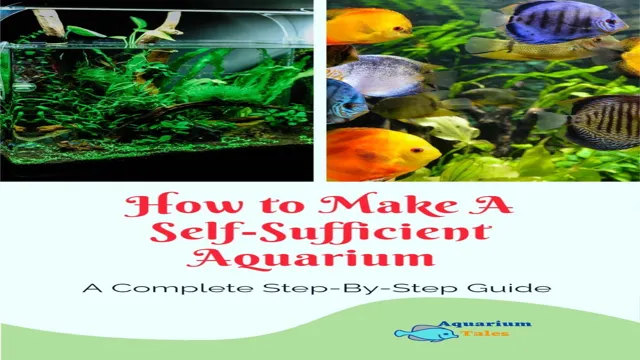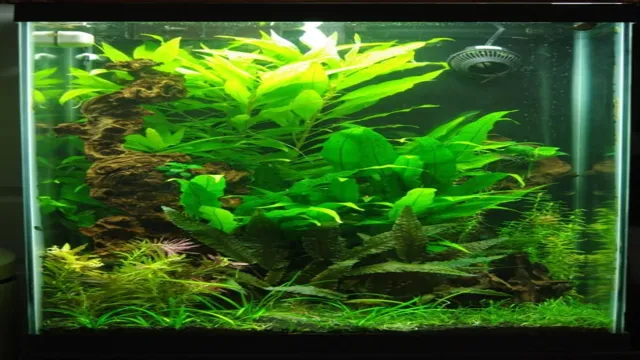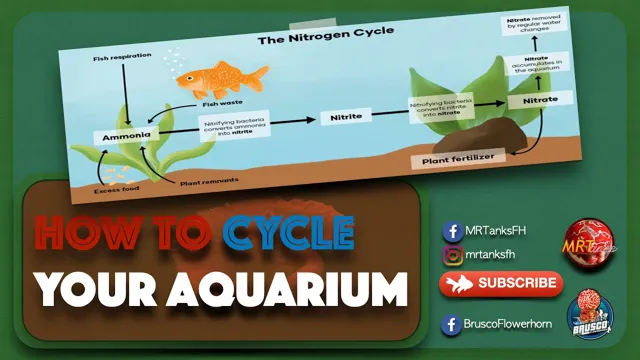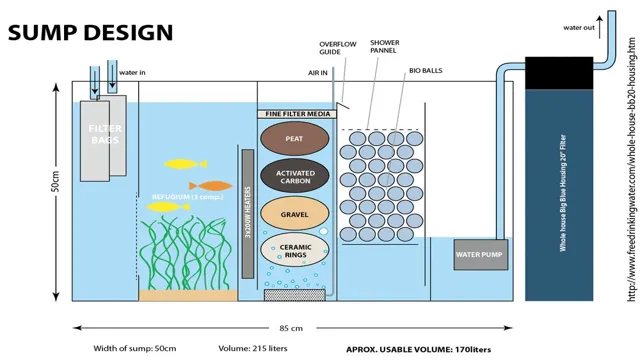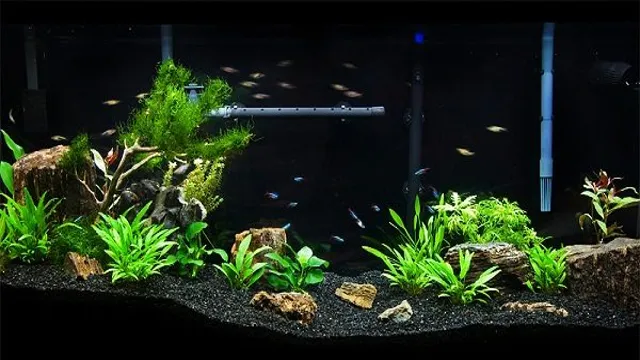A self-sustaining aquarium is not only a beautiful addition to any home, but it is also a rewarding and low-maintenance way to care for aquatic life. The concept is simple: creating an ecosystem within the tank, whereby the fish, plants, and microorganisms work together to maintain a healthy and balanced environment. It may seem daunting to create such a complex system, but with the right knowledge and tools, anyone can achieve a self-sustaining aquarium.
Imagine your aquarium as a small city, with each organism serving a unique role. The plants absorb nutrients and light, creating oxygen for the fish to breathe. The fish produce waste, which is broken down into nitrites and then nitrates by beneficial bacteria.
These nitrates are then used by the plants as food, completing the cycle. By creating this sustainable ecosystem, you eliminate the need for frequent water changes, chemical treatments, and excessive filtration. But how do we get started? First, choose the right size and type of aquarium for your home and the species you want to care for.
Research the specific needs of your plants and fish to ensure they are compatible with each other and the environment you are creating. Start by adding a small number of fish and plants, allowing the system to establish itself before introducing more organisms. Maintaining a self-sustaining aquarium does require some work, such as monitoring water quality and ensuring the balance of the ecosystem.
However, the benefits far outweigh the effort. Not only do you have a stunning display of aquatic life, but you also have a healthy, natural environment that can thrive for years to come. With a little patience and dedication, you too can create a self-sustaining aquarium that will bring joy and tranquility to your home.
Introduction
If you’re interested in creating a self-sustaining aquarium, then you’re in the right place! When done correctly, a self-sustaining aquarium can bring all kinds of benefits to your home. Not only can they be a beautiful addition to your living space, but they also require less maintenance than traditional aquariums. The key to creating a self-sustaining aquarium lies in the balance of the ecosystem within it.
With the right combination of plants, animals, and natural filtration systems, you can create a thriving environment that requires little to no intervention from you. By incorporating a variety of aquatic organisms that rely on each other, you can create a self-sustaining system that will continue to thrive long after you’ve set it up. So, if you’re interested in learning how to make a self-sustaining aquarium, keep reading!
Why a Self-Sustaining Aquarium is Important
Having a self-sustaining aquarium is important for many reasons. For one, it can save you time and money. With a self-sustaining aquarium, the ecosystem is designed to maintain itself without much intervention from the owner.
This means you don’t have to constantly clean the tank or replace filters, which saves you both time and money in the long run. In addition, a self-sustaining aquarium is better for the fish and other aquatic creatures that live in it. The natural balance of the ecosystem promotes healthier organisms and reduces stress on the fish.
This leads to fewer health problems and a longer lifespan for your aquatic pets. Overall, a self-sustaining aquarium is an investment that can benefit both you and your aquatic friends.
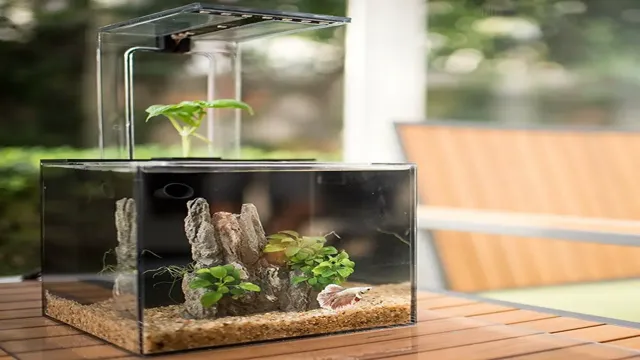
What Makes an Aquarium Self-Sustaining?
When it comes to aquariums, self-sustaining systems are the holy grail of fish-keeping. But what does it really mean for an aquarium to be self-sustaining? Essentially, it means the aquatic ecosystem within the tank is able to thrive without the need for external intervention – aside from regular maintenance, of course. To achieve this, a number of factors need to be in balance, such as proper filtration, sufficient oxygenation, and a healthy balance of fish and plant life.
With a little bit of extra care and attention to detail at the outset, you can create an aquarium that not only looks beautiful but supports itself over the long term, without you needing to constantly worry about the health and wellbeing of your aquatic pets.
Setting Up the Aquarium
Making a self-sustaining aquarium is easier than you might think. To set it up, start with a sturdy tank that can hold at least 10 gallons of water. Add a layer of substrate, such as gravel, to the bottom of the tank.
Then, decorate the tank with plants and rocks to provide hiding places for the aquatic life inside. It’s also important to add a filter to keep the water clean and oxygenated, as well as a heater to maintain a consistent temperature. Once you’ve added water and turned on the equipment, it’s important to cycle the tank.
This means adding ammonia, either through fish food or pure ammonia, to the water so that beneficial bacteria can establish and break down the harmful chemicals in the water. Once the cycle is complete, you can add fish and other aquatic life to your beautiful, self-sustaining aquarium. With proper maintenance and care, you can enjoy a thriving ecosystem right in your own home.
Choosing the Right Tank Size and Location
When it comes to setting up your aquarium, one of the most important decisions you’ll make is selecting the right tank size and location. The size of your tank will depend on the species of fish you want to keep and how many you plan on having. It’s important to choose a tank that is big enough to accommodate your fish comfortably, without overcrowding them. (See Also: How to Lower pH of Tap Water for Aquarium: Simple Methods)
In addition, the location of your tank is also crucial. You’ll want to choose a spot that is away from direct sunlight and heat sources, as this can cause temperature fluctuations and stress for your fish. Make sure the location is also easily accessible for maintenance and cleaning.
By taking the time to select the right tank size and location, you’ll create a comfortable and healthy environment for your fish to thrive in.
Using Live Plants and Substrate
If you want to set up an aquarium that mimics the natural environment of fish, using live plants and substrate is the way to go. Not only do they provide a beautiful aesthetic, but they also create a healthier environment for your fish. When setting up your aquarium, it’s essential to choose the right substrate for your plants to thrive.
You can choose from various types of substrate, such as sand, gravel, or soil. Sand is great for delicate plants like dwarf hairgrass, while gravel is ideal for sturdy plants like Anubias barteri. Once you’ve chosen your substrate, it’s time to add in your live plants.
It’s essential to choose plants that are compatible with your fish and provide them with the necessary nutrients they need to survive. You can choose from various types of plants like Amazon sword, Java fern, or Anubias nana. Finally, ensure that you place your plants in the right location in your aquarium.
Some plants do best in the foreground, while others thrive in the background. By incorporating live plants and substrate into your aquarium set up, you’re not only creating a stunning environment for your fish, but you’re also enhancing their living conditions.
Selecting the Proper Lighting and Filtration
Setting up an aquarium can be both an exciting and daunting task. One crucial aspect of this process is selecting the proper lighting and filtration. Adequate lighting is essential for the health and growth of your fish and plants.
When choosing lighting, it is important to consider the type of aquarium you have, as well as the types of fish and plants living inside. For instance, if you have a planted aquarium, you will need a light with a higher Kelvin temperature to promote photosynthesis. On the other hand, if you have a fish-only tank, a lower Kelvin temperature will suffice.
Additionally, filtration is also essential in maintaining a healthy aquatic environment. Filtration helps eliminate waste, excess nutrients, and harmful chemicals, ensuring the survival of your fish and plants. When selecting a filtration system, factors such as the size of your aquarium and the type of fish you have must be taken into consideration.
Choosing the right lighting and filtration system can be critical in the success of your aquarium, so it is wise to do thorough research before making a decision.
Cycling the Aquarium
If you’re looking to create a self-sustaining aquarium, there are a few key elements to consider. The first is making sure you have a proper filtration system that can handle the waste produced by your fish and other aquatic life. A good option is a cycling system, where the water is constantly filtered through a series of natural elements like plants and algae that help clean the water.
Additionally, choosing the right fish and plants for your aquarium can make a world of difference in the health of your ecosystem. Some species of fish, like shrimp and snails, can help keep the tank clean by eating algae and other waste, while adding live plants can help oxygenate the water and create a natural habitat. Overall, creating a self-sustaining aquarium takes some effort and research, but once established, can be a beautiful and rewarding addition to any home.
Understanding the Nitrogen Cycle
The nitrogen cycle is a vital process in maintaining the health of an aquarium. It involves the conversion of ammonia, which is toxic to fish, into nitrite and then nitrate, which is less harmful. The natural process is carried out by beneficial bacteria that live on surfaces within the aquarium, such as the filter and substrate.
To cycle an aquarium and establish a healthy environment, it’s important to introduce ammonia into the tank, either through the addition of fish or pure ammonia. The bacteria will then begin to convert the ammonia into nitrite, and eventually nitrate. This process can take several weeks, during which time the water will need to be regularly tested for ammonia, nitrite, and nitrate levels. (See Also: How to Make a Small Aquarium Community: A Comprehensive Guide for Beginners)
It’s important to note that a sudden spike in ammonia or nitrite levels can be harmful to fish, so it’s best to slowly introduce new fish over time rather than all at once. Proper maintenance of the aquarium, including regular water changes and cleaning of the filter, can also help to keep levels of ammonia and nitrite under control. In short, understanding and properly cycling the nitrogen cycle is essential for the health and well-being of fish in an aquarium.
By providing a suitable environment for beneficial bacteria to thrive, and monitoring water conditions regularly, aquarium enthusiasts can ensure a happy and healthy fish population.
Starting the Cycle
Starting the aquarium cycle is a crucial first step before adding any fish to your tank. Cycling is the process of establishing beneficial bacteria in your aquarium that will break down harmful toxins produced by fish waste, uneaten food, and decaying plants. The cycle starts when you add a source of ammonia, such as fish food or pure ammonia solution, to your tank.
As the ammonia level rises, a type of bacteria called Nitrosomonas will begin to multiply and convert ammonia into nitrite. Then, another type of bacteria called Nitrobacter will develop and convert nitrite into less harmful nitrate. Nitrate can be removed through regular water changes or absorbed by live aquarium plants.
The entire cycle can take several weeks to complete, and it is essential to test the water regularly to track ammonia, nitrite, and nitrate levels. With patience and attention to detail, you can successfully cycle your tank and create a healthy environment for your fish to thrive.
Maintaining a Self-Sustaining Aquarium
Creating a self-sustaining aquarium may seem like a daunting task, but it is definitely achievable with the right tools and knowledge. One of the most important aspects of maintaining a self-sustaining aquarium is choosing the right plants and animals that can coexist in a healthy ecosystem. This involves creating a balance between producers, consumers, and decomposers that will work together to create a sustainable environment.
Additionally, proper filtration and water management are essential to ensuring that the water remains clean and healthy for the aquatic life. One great way to promote a healthy ecosystem in your aquarium is by incorporating live plants which can help with oxygen production and can absorb harmful chemicals in the water. Remember, the key to a successful self-sustaining aquarium is regular monitoring and maintenance.
With a little bit of effort and patience, you’ll have a thriving aquatic ecosystem in no time!
Monitoring Water Parameters
Maintaining a self-sustaining aquarium requires monitoring water parameters regularly. This ensures that the aquarium environment remains stable and safe for fish and other aquatic life. One of the most important parameters to monitor is pH levels.
A high or low pH can cause stress and illness in fish and can even lead to fatalities. Ammonia and nitrate levels are also crucial to monitor as they can quickly build up, causing harm to the aquarium’s inhabitants. Additionally, monitoring water temperature is essential as it affects the biological and chemical processes in the aquarium.
Being mindful of these parameters and routinely testing the water can help prevent problems before they arise and maintain a healthy and thriving aquarium ecosystem. Remember: a little bit of prevention can go a long way in ensuring a sustainable aquatic paradise for your finned friends.
Feeding and Caring for Your Fish
Maintaining a self-sustaining aquarium is essential for the long-term health and well-being of your fish. One of the most critical aspects of this is feeding them a balanced diet. Overfeeding can quickly turn your tank into a murky, smelly disaster, while underfeeding can lead to malnourishment and stunted growth.
Finding the right balance can take some trial and error – start with a small amount of food and observe your fish’s behavior for signs of hunger or sickness. Additionally, incorporating live plants into your tank can help create a self-sustaining ecosystem where waste products are naturally recycled. Regularly cleaning and maintaining your tank’s filter, heater, and other equipment can also help prevent the build-up of harmful bacteria or toxins.
By providing a healthy environment and taking care of your fish’s essential needs, you can enjoy a thriving aquarium that’s a joy to watch.
Cleaning and Maintenance Tips
Maintaining a self-sustaining aquarium can be a rewarding but challenging experience. One essential aspect of maintaining a healthy aquarium is ensuring proper cleaning and maintenance. First, make sure to regularly remove any debris, uneaten food, and dead plants or fish from the tank. (See Also: How to Add Salt to Aquarium Water – The Ultimate Guide for Beginners)
This will help keep the water clean and prevent any harmful buildup of toxins or waste. Additionally, consider investing in a quality filter and regularly replace the filter media to ensure it is functioning properly. Another crucial step is to perform regular water changes, replacing a portion of the water every few weeks to keep the water chemistry balanced.
It’s also essential to monitor the water parameters regularly to ensure they remain within the appropriate range. By taking these steps and staying consistent with maintenance, you can create a self-sustaining ecosystem in your aquarium that provides a healthy, beautiful home for your aquatic pets.
Conclusion
In conclusion, creating a self-sustaining aquarium may seem like a daunting task, but with a little bit of patience, research, and commitment, it can be achieved by anyone. Just like in life, balance is key – finding the right ratio of plants, fish, and beneficial bacteria can lead to a thriving underwater ecosystem where all elements work in perfect harmony. So dive in and let the magic of nature unfold before your eyes.
With a self-sustaining aquarium, not only will you have a beautiful display to enjoy, but you’ll also be doing your part in creating a sustainable environment for our precious aquatic life. Who needs a therapist when you can have the mesmerizing tranquility of an aquatic world to calm your mind and soothe your soul?”
FAQs
What is a self-sustaining aquarium?
A self-sustaining aquarium is an aquarium system that can maintain a healthy and balanced environment on its own, without frequent maintenance from the owner.
How can I make my aquarium self-sustaining?
To make your aquarium self-sustaining, you can incorporate a variety of aquatic plants, use a natural filtration system such as a wet/dry or fluidized bed filter, and limit the number of fish to prevent overstocking.
What types of aquatic plants are best for a self-sustaining aquarium?
Aquatic plants that are easy to care for and can thrive in a variety of conditions are best for a self-sustaining aquarium. Some examples include Java fern, Anubias, and Amazon swords.
How often do I need to feed my fish in a self-sustaining aquarium?
In a self-sustaining aquarium, fish can get their food from the natural ecosystem. However, it is still recommended to feed the fish once or twice a week to supplement their diet.
How do I maintain water quality in a self-sustaining aquarium?
Regular water changes are not necessary in a self-sustaining aquarium, but it is still important to test water quality regularly. You can also add natural water clarifiers, such as Purigen or activated carbon, to maintain clear water.
Can I add other creatures to a self-sustaining aquarium besides fish?
Yes, you can add other creatures such as snails, shrimp, and even small crabs to a self-sustaining aquarium. These creatures can help clean and maintain the ecosystem.
How long does it take for a self-sustaining aquarium to establish?
It can take anywhere from a few weeks to several months for a self-sustaining aquarium to establish, depending on the type of system and the number of plants and fish. Patience and careful monitoring are key to success.

